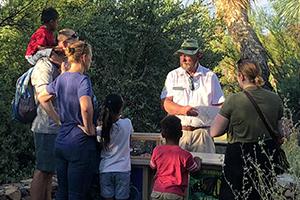The Gulf of California Invertebrate Database:
The Invertebrate Portion of the Macrofauna Golfo Database

Parchment tube worm (Polychaeta; Chaetopteridae). Photo by Larry Jon Friesen
Introduction and Background
The Macrofauna Golfo Project compiled a complete database of all animals known from the Gulf of California (Sea of Cortez, Mar de Cortés). The invertebrate portion of the database is now on the Arizona-Sonora Desert Museum website, and presumably you are about to view this "Gulf database." The information below provides background on the Gulf Database and will help you understand how to maximize your use of this large compilation. We hope to have the vertebrate portion of the database on-line soon.
The Gulf invertebrate database includes all invertebrate groups found in the Gulf of California except copepods and ostracods (we're still working on those!). The invertebrate database is managed by Richard C. Brusca (Arizona-Sonora Desert Museum) and Michel E. Hendrickx (Universidad Nacional Autónoma de México, Unidad Académica Mazatlán). It is updated on a regular basis, generally weekly. If you have information that could be used to update the database, we encourage you to send us an email (rbrusca@hwfj-art.com, michel@ola.icmyl.unam.mx).

Octopus bimaculoides. Photo by Larry Jon Friesen
The Gulf of California is listed among the world's top seas with regard to both productivity and biological diversity. The richness of the marine fauna of the Gulf has long attracted the attention of scientists from around the World. However, threats to the health and integrity of this sea are multiplying rapidly. The scientifically reliable data held in the Macrofauna Golfo Database is a strategic element in developing regional biodiversity conservation plans for Gulf of California. Data compilation for the Macrofauna Golfo Project was a 10-year effort (1995-2005), with participation by dozens of professionals in Mexico and the U.S., cataloging the known fauna of the region. An abridged (printed) version of the invertebrate data was published by the Arizona-Sonora Desert Museum Press in 2005 as a "distributional checklist" (Hendrickx, et al. 2005).
The Macrofauna Golfo project was funded by grants from Conservation International, CONABIO (Comisión Nacional para el Uso y Conocimiento de la Biodiversidad - Mexican National Commission for the Knowledge and Use of Biodiversity), Homeland Foundation (now Marisla Foundation), CIAD (Centro de Investigacion en Alimentacion y Desarrollo), and the Arizona-Sonora Desert Museum. Lead investigators on the project were: Richard C. Brusca, Lloyd T. Findley, Philip Hastings, Michel E. Hendrickx, Jorge Torre and Albert van der Heiden.
How To Search The Database
The simplest searches of the database involve one variable, such as a species name (e.g., Heliaster kubiniji), or other taxon name (e.g., family Heliasteridae). Or a search for an ecological variable that requires a single entry parameter (e.g., the question, "what species live in the intertidal zone" requires simply searching for the value "0 meters" in the "shallowest recorded depth" field).
More complicated searches may require searching for specific values in multiple fields simultaneously. For example, to ask the question, "what intertidal species also live throughout the continental margin (i.e., to a depth of at least 200 m)," simply search for a value of "0 meters" for the "shallowest depth" field and ">199 meters" for the "greatest depth" field.
To ask a georeference question, use the lat/long fields. For example, to ask the question, "what species live between 29° N and 28° N on the mainland coast" (roughly, the Canal del Infiernillo), search "NE latitude" for records ">28°," and "southeast latitude" for records "<29°" simultaneously. Other examples of searches are provided on the database home page.
For "range end points," if all 9's appear in the results it implies that the data are unknown.
Detailed Description of Database

Brittlestar, Ophiothrix spiculata. Photo by Larry Jon Friesen
Taxonomic Scheme
The sequence of higher taxa follows a standard taxonomic (Linnean) hierarchy. The higher classification for invertebrates generally follows ITIS, which in turn largely follows Brusca and Brusca (1990). Following ICZN recommendations, species/subspecies names are followed by the surnames of the author(s) who first described and named that species/subspecies, and the year when the description first appeared in the scientific literature. Parentheses around authors' names (and year) indicate that the species has been reassigned to a genus other than the one in which it was originally placed, subsequent to its original description.
Detailed Information on Distributional Data
Only animals with a recorded presence in at least one of the three faunal regions inside the Gulf of California (the "Gulf") (see map below) are included in the list - the Northern Gulf, Central Gulf and Southern Gulf. Below the taxonomic data for each species/subspecies is information on its geographic distribution arranged in four categories. The first category presents the distribution of the species/subspecies in the Gulf based on its recorded or known occurrence in one or more of the four faunal regions we have defined for the Gulf and adjoining shelf waters of southwestern Baja California Sur (see map below). The second and third categories of distributional information provide the northernmost and southernmost known limits of the species within the eastern Pacific (whether inside or outside of the Gulf). The fourth category provides worldwide distributional data, using standard biogeographic divisions, and also includes records for the major oceanic islands of the eastern Pacific.

Beak of jumbo squid (Dosidicus gigas). Photo by R. Brusca
First distributional category. As shown in the map below, we divide the Gulf into three faunal regions, based on the analysis of Walker (1960) as modified by Thomson et al. (1979). We also recognize the transition zone of the southwestern Baja California peninsula. Thus, the faunal regions we use are as follows. The Northern Gulf (Golfo de California Norte; GCN) extends from the Colorado River Delta southward to Bahía San Francisquito (Baja California) and Bahía Kino (Sonora), and includes the Midriff Islands (Islas del Cinturón). The Central Gulf (Golfo de California Central; GCC) ranges from the southern border of the GCN to Guaymas (Sonora) on the mainland coast, and to Punta Coyote (Baja California Sur) on the Baja California peninsula. The Southern Gulf (Golfo de California Sur; GCS) extends southward to Cabo Corrientes, Jalisco, on the mainland coast, and to Cabo San Lucas at the tip of the Baja California Peninsula. The Southwest Baja California Sur region (Suroeste de Baja California Sur; SBC) extends up the west coast of the Baja California Peninsula from Cabo Falso (near Cabo San Lucas) to the northern limit of the Bahía Magdalena lagoon complex at Boca de Las Ánimas. Note, however, that a species listed as occurring in the Northern Gulf only might have records elsewhere in the eastern Pacific, outside the Gulf of California (e.g., Costa Rica, California). In such cases we rely on collection data and do not assume that its distribution is continuous along the west coast of the Americas between the reported localities (although it may well have such a distribution, as most Tropical Eastern Pacific species do).
Second and third distributional categories. The categories "Northern Limit" (Límite Norte) and "Southern Limit" (Límite Sur) provide the recorded distributional limits of a species in the eastern Pacific Ocean, potentially including the entire distance between the Gulf of Alaska to the waters of Tierra del Fuego. The extreme eastern Pacific range records appearing in these second and third distributional categories have been gleaned from the literature and in some cases represent localities where a species has been recorded only rarely. Within Canada, the U.S.A. and Mexico, the place names of these distributional range points in the eastern Pacific are represented by standardized political abbreviations of the country, followed by the coastal state or province and, if available, specific place names. When no reliable specific geographic place name was available for a species, the abbreviation of the state/province, or the country, may be followed by its name (e.g., PAN, Panamá; MEX, SON, Sonora) to emphasize that the absence of a discrete place name is not due to a typographical error or omission. In the case of some, older records from the Gulf of California that provided no specific locality data, the entry appears simply as "MEX, Golfo de California." (See List of Acronyms for abbreviations used.)

Periwinkles (Nodilittorina). Photo by Larry Jon Friesen
Although one abbreviation is duplicated (BC = British Columbia; BC = Baja California), the initial country abbreviation will leave no doubt as to the locality (Canada Vs. Mexico). On rare occasions where no eastern Pacific distributional limits are known, or could not be accurately surmised, the acronym "ND" (no data) appears. We use the convention of presenting place names as they are spelled in the language of that country (i.e., English, if in USA or Canada; Spanish, if in Latin America). When available, names of political entities smaller than states are sometimes employed where geographic precision deserves clarification. An example is counties in the USA (abbreviated "Co."). When latitudinal/longitudinal coordinates are more appropriate (e.g., a far-offshore record), these are given in addition to or in lieu of place names.
An important point to bear in mind for the Northern and Southern Limits are cases in which one or both of these distributional limits falls both inside the Gulf and on the outer (western) coast of the Baja California peninsula. In order to clarify the distribution of such animals, we present both localities (if known). In such cases, the distributional limit on the western side of the peninsula is given first (e.g., "MEX, BCS, Laguna San Ignacio"), followed by the limit reached by that animal inside the Gulf (e.g., MEX, BCS, Santa Rosalía).
Specific locality place names are spelled out except for three abbreviations: B. = Bahía or Bay; I. = Isla or Island; Is. = Islas or Islands. Other names or standard abbreviations in this section include: Punta, Point; Cabo, Cape; Mar, Sea; Océano, Ocean; Puerto, Port; Cuenca, Basin; Fosa, Trench (oceanic); frente a, offshore (from a stated locality); N, S, E, or W de, north, south, east, or west of (a stated locality).
For species occurring both in continental waters and waters around oceanic islands in the eastern Pacific Ocean, all southernmost range limits are given as the southernmost recorded continental locality, and its recorded occurrence at an oceanic island or island group is noted in the fourth distributional information category of "World distribution" ("Distribución mundial").

Mantis shrimp (Squillidae). Photo by Larry Jon Friesen
Fourth distributional category. Although this fourth distributional category emphasizes the geographic distribution of animals in the eastern Pacific Ocean, it also attempts to outline each species' worldwide distribution (distribución mundial). Major regions of the world ocean where a species has been recorded are presented by their acronyms (see List of Acronyms). Here, however, the eastern Pacific Ocean has been subdivided to a finer extent than other parts of the world ocean, and it is noted by three principal subareas (PET; PNET, PSET), oceanographically defined by location and prevailing ocean surface temperatures. PET is equivalent to the Tropical Eastern Pacific of many authors, PNET is equivalent to the Temperate Northeastern Pacific, and PSET to the Temperate Southeastern Pacific. (See Brusca and Wallerstein 1979)
As noted above, this fourth category also presents the recorded occurrence of animals at the offshore oceanic islands of the eastern Pacific Ocean, especially those within the Tropical Eastern Pacific. Because the Gulf of California is considered part of the Tropical Eastern Pacific, all species in this checklist bear the acronym PET (Pacífico Este Tropical).
COS (cosmopolitan) refers to those species that are widespread in the world's oceans and seas, whereas CT (circumtropical) refers to species distributed broadly in the world's tropical regions. However, the use of these acronyms in the world distribution category should be interpreted with caution. For some widespread but poorly studied species, this might be the only distributional data available in the literature, especially in cases where no modern reports of the species exist. In a few cases, we were unable to confirm the presence of a given "COS/CT species" in one or several regions in the world. Consequently, when COS or CT are used it should be understood that this might reflect only a very widespread distributional range, and not necessarily the fact that the species has been literally recorded in every geographic region or subregion around the world (or in the world's tropics).
Finally, in this fourth category of distributional information, animals deemed to be endemic to the Gulf of California as we have herein defined it are represented by the acronym ENGC (Endemic to the Gulf of California; Endémica del Golfo de California).

Pen of jumbo squid (Dosidicus gigas). Photo by R. Brusca
List of Acronyms Used in the Macrofauna Golfo Database
Some papers and books that cite data from the Macrofauna Golfo database
Citations
Please cite this Internet site as:
Brusca, R. C. and M. E. Hendrickx. 2008 and onward. The Gulf of California Invertebrate Database: The Invertebrate Portion of the Macrofauna Golfo Database. http://1etm.hwfj-art.com/center/seaofcortez/database.php.
Regions of the Gulf

Literature Cited
Brusca, R. C., and G. J. Brusca. 1990. Invertebrates. Sinauer, Sunderland, Massachusetts.
Brusca, R. C. and B. R. Wallerstein. 1979. Zoogeographic patterns of idoteid isopods in the northeast Pacific, with a review of shallow-water zoogeography for the region. Bulletin of the Biological Society of Washington 3: 67-105.
Hendrickx, M. E., R. C. Brusca, and L. T. Findley (eds.). 2005. A Distributional Checklist of the Macrofauna of the Gulf of California, Mexico. Part I. Invertebrates [Listado y Distribución de la Macrofauna del Golfo de California, México, Parte I. Invertebrados]. Arizona-Sonora Desert Museum and Conservation International. 429 pp; available from the Desert Museum).
ITIS (Integrated Taxonomic Information System). http://www.itis.gov/
Thomson, D. A., L. T. Findley, and A. N. Kerstitch. 1979. Reef Fishes of the Sea of Cortez. The Rocky-shore Fishes of the Gulf of California. John Wiley & Sons, New York, New York.
Walker, B. W. 1960. The distribution and affinities of the marine fish fauna of the Gulf of California. Systematic Zoology 9: 123-133.











